Contents
-
Current degree day (DD) accumulations
-
Upcoming meetings
The way I see it
- NEWA Apple Insect Models
- Going green at Red Apple Farm
- Timely and updated fact sheets available on the UMass Fruit Advisor website
Current (through June 15) degree day (DD) accumulations
Location: UMass Cold Spring Orchard (CSO), Belchertown, MA
Base 43: NA
Base 50: NA
Significant upcoming orchard events based on degree days (Base 43):
codling moth first flight peak: 593–1017
obliquebanded leafroller 1st catch: 827–939
obliquebanded leafroller 1st flight peak: 843–1139
dogwood borer 1st catch: 759–1503
rose leafhopper adult on apple: 809–1053
Upcoming meetings
June 16 and 18, 2009: Tree fruit twilight meetings
June 16, 5:30 PM: Clarkdale Fruit Farms, Deerfield, MA
June 18, 5:30 PM: Cook's Valley Farm, Wrentham, MA
July 15, 2009: Massachusetts Fruit Growers' Association Summer Meeting, Tougas Family Farm, Northboro, MA
August 2–5, 2009: International Fruit Tree Association Annual Short Orchard Tour, Nova Scotia, CANADA
December 15-17, 2009: New England Vegetable & Fruit Conference, Manchester, NH
The way I see it
Pretty quiet out there and nothing too notable other than the extended period of cool and showery weather. I have seen white apple leafhoppers (WALH, or rose leafhopper?) in a few orchards, and building populations may warrant treatment sooner or later. Neonicotinoid insecticides such as Provado, Actara, Calypso, Clutch, or Assail provide excellent control. Reminds me, keep on the lookout for potato leafhopper (PLH), particularly in young blocks. I expect they will arrive with the next push of warm air from the south if we ever get one. PLH can do a lot of damage in short order if left unchecked. Ditto on the neonics. Also, it's not too early to hand thin apples and peaches. Multiple benefits include enhanced fruit size and quality, better return bloom in apples, and it allows you to be up close and personal with your foliage to look for Insect and disease problems. And don't forget to keep ripening stone fruit (i.e., cherries) covered with fungicide for brown rot. Hope to see you at the tree fruit twilight meetings this week. J. Clements
NEWA Apple Insect Models
What follows are the display outputs for various NEWA Apple Insect Models run on Monday afternoon. Comments that follow are mine. A reminder you can run these models for an airport location closest to you by visiting the NEWA Apple Insect Models website. J. Clements
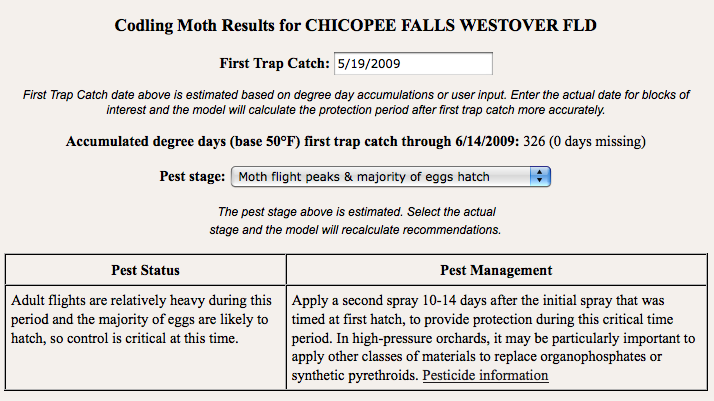
If you have a habitual problem with codling moth, then follow the advice and continue spray(s). Earlier sprays targeting plum curculio may have had an impact on codling moth populations. Insecticide recommendations for codling moth include: Guthion and Imidan; Delegate, Altacor, or Belt; and Voliam Flexi (unsure of registration status in Massachusetts).
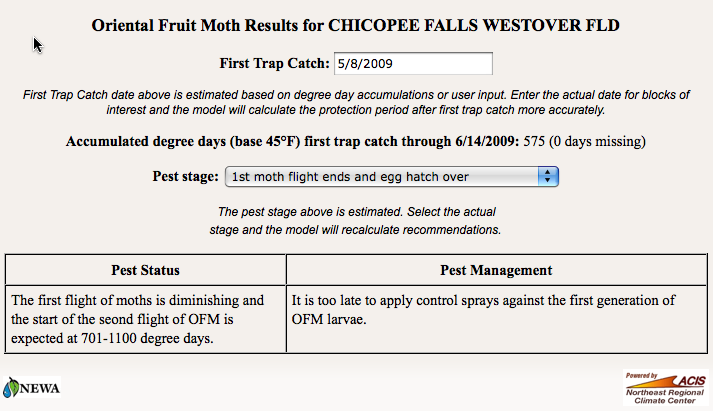
We are in a lull for Oriental fruit moth, and earlier control measures should have been successful, including mating disruption and earlier insecticide sprays in peaches and apples for plum curculio.
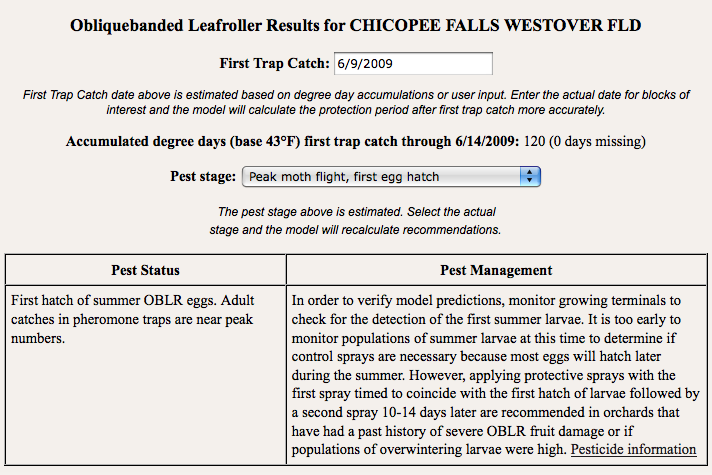
We are at the beginning of an important control period for OBLR. Orchards with an OBLR population as documented by monitoring should be spraying an insecticide by the end of this month. Best control options include: SpinTor, Intrepid, or Entrust; Proclaim, Delegate, Altacor, Belt, or Voliam Flexi. With most of these insecticides, earlier timing is better than late, and good coverage of the foliage is a must -- spray carefully.

Plum curculio is DONE in most orchards. While hand thinning, I am picking up some curculio damage where orchards with a light post-bloom insecticide program.
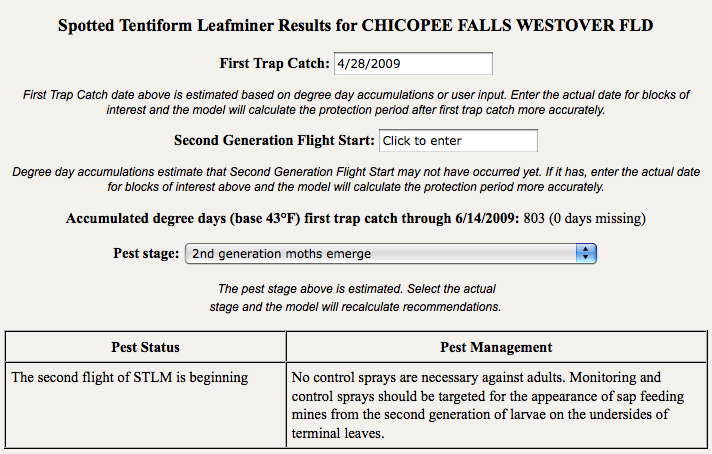
No action is recommended now, however, check back to see when NEWA suggests sap feeding mines will appear based on degree days and trap captures. Controlling STLM is an elusive target at best, however, some orchards experience significant populations which can result in pre-harvest fruit drop. You probably know who you are.
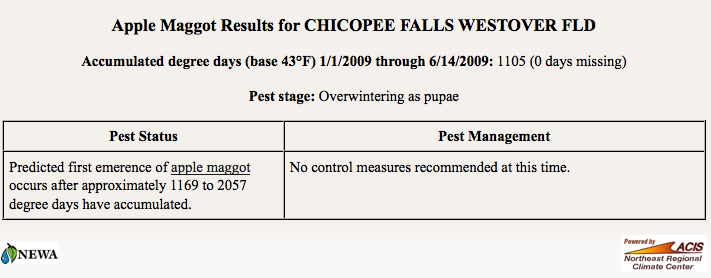
As you can see, no action is necessary. It's interesting to note, however, that we are not that far away from when the first possible emergence of AMF adults based on degree day accumulations. Stay tuned.
J. Clements
Going green at Red Apple Farm
Green talk and 15kW turbine ribbon cutting
Wednesday, June 24, 2009, 3:45 to 7:30 PM (panel talks 4 to 5 PM)
Your hosts: the Rose Family, at Red Apple Farm, 455 Highland Ave., Phillipston, MA
Pre-Register today: 508-755-7400 ext. 229
to Monica Elefterion - melefterion@worcester.org
4:00 pm: Panel discussion & Q & A on sustainable and renewable
energy by:
-NEXAMP
-MA Tech Collaborative
-Johnathan Hyde, Green Tourism, Mass. Office of Travel and Tourism
-Gerald Palano, Alternative Energy Specialist, MA Dept of Agriculture
6:15 p.m.: Ribbon Cutting on 15kW Wind Turbine
Followed by:
FREE "Business After Hours" reception hosted by
Enjoy a local "Taste of Local Tourism": complimentary tastes
and drinks from local vendors with a green commitment!
Timely and updated fact sheets available on the UMass Fruit Advisor website
F-129R--2009 Late Season "Rescue" Thinning with Ethephon
Summary recommendation for "rescue" thinning with ethephon:
- Treat when temperatures are 70-80 F (day of treatment + 2 days).
- Do not treat when below 70 F or above 80 F (day of treatment + 2 days)
- Fruit 15-25 mm diameter (0.8-1 inch)
- McIntosh and Macoun 200-300 ppm (0.7 - 1 pint Ethrel per 100 gallons dilute spray, with 0.5 lbs carbaryl a.i. and a surfactant)
- See the fact sheet noted above for more precautions and details
F-131--2007 Enhancing Return Bloom on Apple with Plant Growth Regulators
Summary recommendation for enhancing return bloom with ethephon
- Begin 4 to 6 weeks after full bloom and after 'June drop'
- Use Ethrel at 0.5 pint per 100 gallons dilute spray -- can be combined with cover sprays
- Make 2 to 3 weekly applications depending on variety (1-2 on early maturing cultivars)
- Avoid applying at high temperatures and/or too early as ethephon can cause significant fruit thinning under the right conditions
- See the fact sheet noted above for more precautions and details
